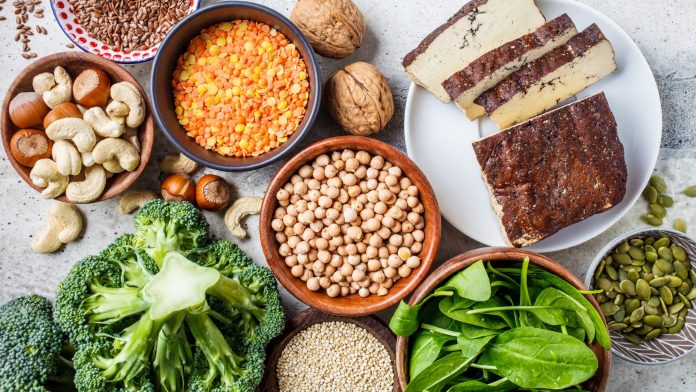Hands down, the number one question a vegan is asked is, “Where do you get your protein?” While vegan protein does indeed exist, it’s not a totally bonkers question, given that the sources of protein most people are familiar with (meat, poultry, eggs, dairy, fish, whey) are all off limits.
But there are actually a ton of surprising and tasty sources of vegan protein, as long as you know where to look. Legumes, seeds, nuts, lentils, whole grains, soy-based products, and plant-based protein powders are where it’s at.
So whether you’re already living that animal product-free lifestyle or just thinking about it—or maybe you’re just looking to enjoy more plant protein into your life—it’s helpful to have a go-to guide to the best vegan protein sources out there. Here are some delicious, filling, and versatile high-protein vegan foods to add to your grocery list.
Tempeh
Made from partially cooked, whole, fermented soybeans, tempeh is a great meat substitute, Dara Godfrey, M.S., R.D., an NYC-based dietitian who works in private practice and with fertility patients at Reproductive Medicine Associates (RMA) of New York, tells SELF. Also rich in copper, manganese, calcium, iron, and fiber, it’s best served steamed, baked, or grilled. The firm texture and nutty flavor soak up other flavors quickly. Godfrey recommends soaking it overnight in fresh garlic with sesame oil and adding it to a stir fry, salad, or soup.
Almond butter
This paste made from almonds is a little grittier than peanut butter and contains more fiber, calcium, potassium, and iron. Try adding a scoop of almond butter on top of your oatmeal, in a smoothie, or slathering it on top of a banana or piece of toast.
Black beans
As a great source of folate, potassium, iron, and fiber, these legumes are earthy in taste and hearty in texture. Whether cooking them dry or using them straight from a can, black beans are great in soups, salads, and of course, tacos.
Hemp seeds
Hemp seeds (often called hemp hearts) taste like something of a hybrid between a sunflower seed and pine nut. They’re also rich in fiber, omega-3 fatty acids, and magnesium. Since they’re versatile, they can be used in both savory and sweet dishes.
Edamame
Tempeh, tofu, soy milk and the like are all fantastic, but it’s hard to beat soybeans in their simplest natural form. These crunchy little guys are fun to eat on their own, straight out of the shell, with a generous sprinkling of coarse salt. Found year-round in the frozen section, there are also pre-shelled bags that will come in pretty handy if you’re making a recipe that calls for large amounts of edamame.
Brown rice protein powder
Protein powder made from rice, you say? Who knew? While pea and soy protein are more popular, this chewy whole grain is an increasingly popular source of post-workout fuel for vegans. Find a variety you like the taste of, and your muscles will thank you.
Buckwheat
Buckwheat’s name is pretty misleading, given it’s not a type of wheat. In fact, like quinoa, buckwheat isn’t technically a grain at all. But this seed certainly stacks up to grains in terms of kitchen versatility and nutritional power. Buckwheat groats can be toasted to enhance their flavor and cooked up like a cereal grain, or ground into a hearty flour that makes for delicious and filling pancakes or noodles (soba noodles).
Chickpeas
Garbanzo beans are as rich in fiber as they are protein, with 11 grams a serving. Your GI tract will be pleased to hear there are about 7,000 ways to cook with them. Roast them with spices for a crispy, salty snack to munch by the handful; gobble them up in pasta form; or puree them into a cookie dough-like dessert hummus to be consumed by the spoonful.



























